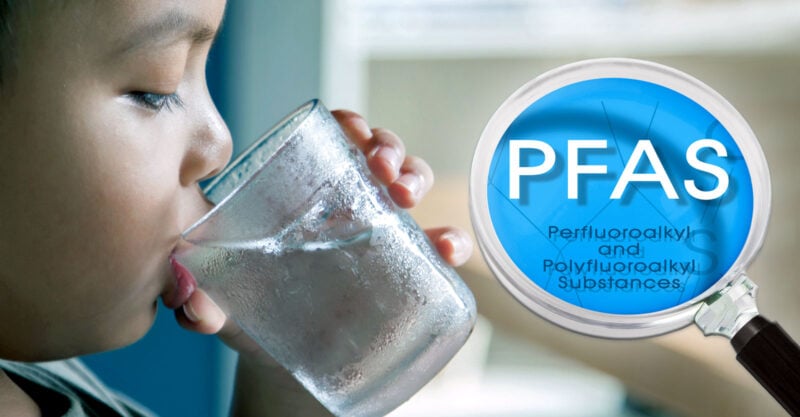A U.S. Geological Survey found 45% of U.S. tap water is contaminated with per- and polyfluoroalkyl substances (PFAS) chemicals, with measured concentrations in both private wells and public water sources.

Please Follow us on Gab, Minds, Telegram, Rumble, Gab TV, GETTR, Truth Social, Twitter
A study in Environment International (August issue) by the U.S. Geological Survey (USGS) finds that almost half of U.S. tap water is contaminated with per- and polyfluoroalkyl substances (PFAS) chemicals, with measured concentrations in both private wells and public water sources.
Authors of the study “estimate that at least one PFAS could be detected in about 45% of U.S. drinking-water samples.” Although there are more than 12,000 different types of PFAS, only 32 are detectable by USGS lab tests, so 45% is likely a low estimate.
PFAS are a group of chemicals found in a variety of common household products such as nonstick pans and stain-resistant carpeting, as well as pesticides and biosolids used as fertilizer.
Long-chain PFAS, such as perfluorooctanoic acid (PFOA) and perfluorooctanesulfonic acid (PFOS), are more widely known because of their high toxicity and controversial use in the past.
Today, long-chain PFAS are often replaced with short-chain PFAS, as the latter are not as bioaccumulative; however, short-chained PFAS also pose a significant threat because they remain highly persistent in the environment.
Past Beyond Pesticides articles have described the prevalence of PFAS in products as well as their negative health consequences, including cancer, decreased fertility, obesity and hormone suppression.
PFAS are concerning because of their persistence in the environment alongside their contamination of food and water.
“The quality and sustainability of drinking water are rising concerns in the United States because of population-driven water demands, increasing contamination of drinking-water resources, and a growing understanding of potential human-health consequences associated with exposures to contaminants,” according to the study’s authors.
PFAS can contaminate drinking water sources as a result of biosolids application, outdoor pesticide use, industrial and wastewater treatment discharges, firefighting foams and septic or landfill system contamination.
The U.S. Environmental Protection Agency (EPA) recently issued health advisories on PFAS, emphasizing that it failed to adequately regulate this group of dangerous chemicals.
Industrial chemical giants Dupont, Chemours and Corteva are currently embroiled in a multi-billion dollar settlement over their role in PFAS water contamination.
Although, as the study’s authors point out, “newly proposed MCLs for PFOA (4 ng/L) and PFOS (4 ng/L) were released in March 2023 by EPA as part of the National Primary Drinking-water Standards Rule,” these standards are not yet enforceable, so contamination remains a pressing issue.
The aim of this study is to compare water samples from private and public wells, highlight in aggregate the consequences of PFAS on human health and determine the primary drivers of PFAS contamination of drinking water.
Water samples from all 50 states, Washington, D.C., Puerto Rico and the U.S. Virgin Islands were collected from 716 point-of-use tap water locations (269 private wells and 447 public water sources) between 2016 and 2021, with PFAS concentration measurements assessed by three different laboratories.
Researchers collected data through a standardized analytical survey with the help of a volunteer network. New data were examined in combination with tap water samples collected by the research team in past years.
Although there are more records of water contaminants from samples gathered directly after treatment and before distribution, there are limited measurements of PFAS contamination at point-of-use (water that directly comes out of household faucets).
This trend holds especially true for private wells, as they are often poorly monitored. As highlighted by the authors of the study, testing before distribution does not account for contamination through “plumbing material with PFAS or sorption/degradation in the supply network.”
After analysis, similar PFAS concentrations were identified in private and public water sources, but increased contamination levels were measured near urban centers, as well as industrial manufacturing and waste facilities that actively use PFAS.
Types of PFAS identified per water source ranged from one to nine and the corresponding amount of PFAS detected ranged from 0.348 to 346 ng/L.
Seventeen different types of PFAS were detected in at least one source and as mentioned above, 45% of the water sources measured contained at least one type of PFAS.
Exposure to PFOA and PFOS are believed to pose the greatest risk to human health, considering their well-documented carcinogenic capacity.
Given the growing body of evidence on the dangers and prevalence of PFAS in our homes, outdoor spaces and human bodies, methods are needed to clean and remediate drinking water sources — and immediately eliminate these toxic chemicals from production and use to protect people and the environment.
More research is needed to investigate how PFAS interacts with other organic and inorganic contaminants.
Additionally, research must identify and address, the geographical regions and subpopulations most affected by PFAS water contamination, as well as ensure that sample monitoring continues for both heavily used public systems and the more sparsely used public and private wells.
Beyond Pesticides offers a variety of articles in the archives detailing the dangers of PFAS and the prevalence of PFAS in pesticides.
Check out Threatened Waters: Turning the Tide on Pesticide Contamination to learn more about the health and safety of water sources.
Originally published by Beyond Pesticides.
“© [Article Date] Children’s Health Defense, Inc. This work is reproduced and distributed with the permission of Children’s Health Defense, Inc. Want to learn more from Children’s Health Defense? Sign up for free news and updates from Robert F. Kennedy, Jr. and the Children’s Health Defense. Your donation will help to support us in our efforts.
Subscribe to our evening newsletter to stay informed during these challenging times!!
How about a map?